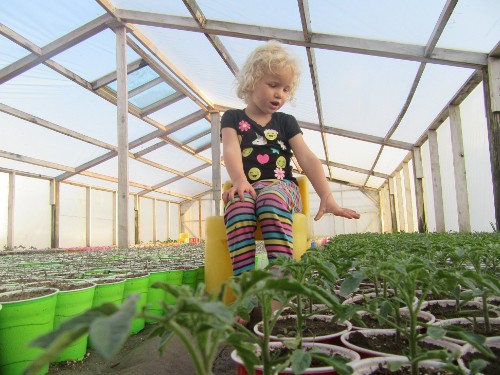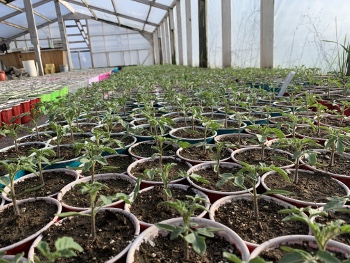| The First Wave
March 21
 
Hello Farm Friends!
Kickoff with Snow!
Yesterday was our first farm work day and it was a success as the asparagus has been cleared and is now ready for tractor work to kick off the season.
I was surprised anyone showed up with the snow flurries and cloudy skies. It felt more like a last farm day of the year as we typically gather in the final harvest as the first cold spell finally arrives in fall. Yesterday was chilly and blustery. The mountains decided to hide from our new farm friends. They tend to get shy like that sometimes. But as soon as everyone left, guess what happened? My mountains came back out to smile with bright white snow caps.
Now it is time to talk about the next project for the upcoming weekend of March 27 and 28.
Montana Planting Season vs. Root Bound Plants
The challenge we have with our spring crop of garden plants is timing for the Montana planting season.
The best time to plant in Montana gardens can swing a few weeks in either direction depending on the spring we get. Also, many of our customers live in locations that have micro-climates that require a later timing for their unique location or allows for early planting. We also grow plants for customers who have their own greenhouse and can start their summer veggies under cover with heat extremely early compared to outdoor growing.
This means the Montana planting season is, technically, from middle of April to mid-June, depending on circumstances.
The logistical challenge that presents is the biological reality of growing plants in containers. Plants do well if they are growing. They tend to go downhill if they cannot grow due to limitations of the container that holds them. We call that problem being "root-bound" and it is sort of like life. Humans do best growing, too. What happens if humans stop growing or learning?
Things get stagnant and unhealthy. New challenges help us grow (like transplanting to a bigger pot) and allows for future growth. Transplanting may be an uncomfortable process. This is why people often want to stay exactly where they have been for many years. They like it there. Transplanting may even be dangerous -- some plants may die.
But it is also necessary because it allows for new growth and new life. If our summer veggie plants never get transplanted, then they might as well be dead already. This is a lesson for life. What you don't want is to get stuck forever in all the same thinking forever. Do you know someone who hasn't changed any of their ideas or beliefs for years and years? Consider that the proper term for that problem is being "root-bound." It stunts growth and bars future possibilities for amazing things to come into being -- just like plants.
The First Wave
The way we deal with this "root-bound" problem at Covenant Gardens (regarding plants, at least) is to plant in waves.
So we will have an early batch of plants for the early markets. But these plants will only be marketable for a set amount of time before they collapse in quality. We call this the "First Wave." Then we wait the appropriate amount of time and we seed another batch of plants for the main season time where the bulk of our plants go out into gardens. We call this the "Second Wave." But even these plants will have a limited marketability period before they are not sellable. Then we will wait the appropriate time and plant the late batch, the "Third Wave" for late plantings at high elevations or in colder micro-climates (like Butte for example).
The term for this process is sometimes called "succession planting," but it is a little more complicated for Covenant Gardens. We are timing our waves also based on the amount of time it takes for the selection to be ready for sale. Not all things grow at the same speed. Peppers take longer than cucumbers. So all of that biological information is taken into account as we plan out and schedule our various waves of plantings.
Think of it more like a symphony of inter-related timings that all work together for plants to be ready simultaneously at the appropriate time.
This weekend will mark the beginning of our first wave of transplanting.
Seeds are coming up in our germination room so it is time to surf the first wave
Limited Participants for Transplanting
We could use a few helpers to join us as we transplant in the greenhouse this weekend. We are hoping to have our first 4000 plants or more completed by the end of this coming weekend. We will be working both Saturday and Sunday.
Due to the intricate work and detail required I will need to limit how many people can join us for this work project to about 3 helpers at one time.
However, this work can be tedious and hot and sweaty work (the greenhouse usually runs about 80-90 degrees), so I would recommend those interested to join us for a morning session of transplanting or an afternoon session of transplanting, no more than 3-4 hours at a time. It tends to be tiring work.
If you would like to join us, please respond to this email about which morning/afternoon you could join us in the greenhouse and I will let you know if it is available. So, we would have Saturday morning, Saturday afternoon, Sunday morning, and Sunday afternoon available. That schedule will open up more opportunities for more farm friends to join us as they are interested.
Plan on heat if you can make it out. Shorts, sandals, sunburns! Think summer...
Blessings,
Tim Martin
CovenantGardens.com
|
|

